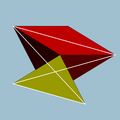Pseudo great rhombicuboctahedron
| Pseudo great rhombicuboctahedron | |
|---|---|

| |
| Type | Pseudo uniform polyhedron, Star polyhedron |
| Elements | F = 26, E = 48 V = 24 (χ = 2) |
| Faces by sides | 8{3}+(8+8+2){4} |
| Symmetry group | D4d |
| Properties | singular vertex figure |
 4.4.4.3/2 Vertex figure |
 Pseudo great deltoidal icositetrahedron (dual polyhedron) |
In geometry, the pseudo great rhombicuboctahedron is one of the two pseudo uniform polyhedra, the other being the convex elongated square gyrobicupola or pseudo rhombicuboctahedron. It has the same vertex figure as the nonconvex great rhombicuboctahedron (a uniform polyhedron), but is not a uniform polyhedron (due to not being isogonal), and has a smaller symmetry group. It can be obtained from the great rhombicuboctahedron by taking a square face and the 8 faces with a common vertex to it (forming a crossed square cupola) and rotating them by an angle of π⁄4. It is related to the nonconvex great rhombicuboctahedron in the same way that the pseudo rhombicuboctahedron is related to the rhombicuboctahedron.
Related polyhedra
The pseudo-great rhombicuboctahedron may also be termed an elongated crossed square gyrobicupola, in analogy to the name of the elongated square gyrobicupola.
 Great rhombicuboctahedron |
 Pseudo great rhombicuboctahedron |
References
- Grünbaum, Branko (2009). "An enduring error". Elemente der Mathematik. 64 (3): 89–101. doi:10.4171/EM/120. MR 2520469.
{{cite journal}}: Invalid|ref=harv(help). Reprinted in Pitici, Mircea, ed. (2011). The Best Writing on Mathematics 2010. Princeton University Press. pp. 18–31..
External links
- George Hart - Pseudo Rhombicuboctahedra
- Klitzing, Richard. "gyquerco".
